Disappointed with my LED recessed lights ... what now?
My LED recessed lights (Cree 6'' 2700K) were installed yesterday. I really had high hopes for these lights. Aside from the high price, they seemed to have everything going for them. I really like that they are super energy-efficient, as well as dimmable, available in a warm color, high CRI, and with no mercury.
But, now that they are installed, I'm disappointed. To their credit, they actually put out a lot more light than I was anticipating, but consequently I find that it is now too bright in my kitchen. Perhaps it would be better with fewer lights or if i had higher ceilings (mine are only 8').
The biggest problem for me is the dimming. When dimmed, there is a faint buzzing sound. I don't know if this is normal, or a problem with my installation. My dimmer switch and housing are both listed as compatible on the Cree website.
Also when dimmed, there seems to be some slight flickering resulting in a bit of a strobe effect. I can't see the flickering when I look at the lights, but it just gives a slightly odd effect in the room. Again, I don't know if this is normal or not.
So now I'm looking for suggestions on what I should do.
Here is a diagram that shows approximately where my lights are installed ...
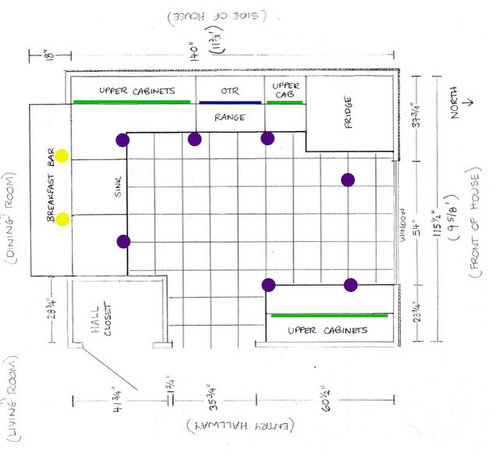
Comments (48)
lightguy
15 years agoI think your best bet is to contact the place you purchased them from to help you out with that. They may have some experience with it.
I've never heard of the buzzing before.
There also might be an issue with the input wiring in your house. I've seen that affect low voltage lights due to the transformer. And since the LED does use a power supply, if you have something funky going on the line (house power) side of the fixture, that can affect the light.
An easy step is to test it with a normal non dimming toggle switch. See if that gives you the strobe or the buzzing.
Anyway though, definitely call your supplier and see what they say.
Good luck!
Related Professionals
Greer Furniture & Accessories · Owensboro Furniture & Accessories · Scottsdale Furniture & Accessories · Silver Spring Furniture & Accessories · Newton Furniture & Accessories · Rancho Santa Margarita Furniture & Accessories · Middle Island Interior Designers & Decorators · Westbury Interior Designers & Decorators · Rosaryville Interior Designers & Decorators · Concord Electricians · Del City Decks, Patios & Outdoor Enclosures · Fredericksburg Decks, Patios & Outdoor Enclosures · Greeley Decks, Patios & Outdoor Enclosures · Highland Springs Decks, Patios & Outdoor Enclosures · Montgomery County Decks, Patios & Outdoor Enclosuresaussies
Original Author15 years agoThe dimmer I'm using is Leviton Illumatech IPI06-1L, which is on the list of recommended dimmers.
I'm going to the store I bought them from tomorrow. At this point I think I will have to return them and put in some other kind of bulbs. I'm finding that the strobing is actually giving me motion-sickness. How bizarre!
What kind of bulbs should I get?
beachcomber3
15 years agoTexasredhead,
I was told not to use halogen lights for my recessed lighting because it produces too much heat. Is this true?
What do you recommend for 5 inch halo recessed lights?
Thanks!bhhstudios
15 years agoaussies,
Could you please post photos of the installation, the more the merrier. I am building a garage with a photo studio on top and was planning on using all cree for indoor and outdoor but I am now weary because of this post.
Its bizarre that your problem is that they are too bright, is it possibly because they are so focused? What about some diffuser discs over the holes? That would help soften the light and give it more spread would it not?
Anyway, I am very interested in the set up and would really love to see everything.
Thank you.
aussies
Original Author15 years agoIt really is bizarre that it's too bright. I was really just prepared for there to be too little light. In all my research of LED lights, some people had mentioned that they weren't bright enough yet but I don't think anyone had suggested they might be too bright. Clearly this is my error in simply having too many of them in my small space. But I just never anticipated this. Also my general assumption is that if you have too much light, then you just dim to the desired amount. So that's one reason that I'm disappointed with the dimming capability. I'm just not able to dim low enough.
I don't think it's that the lights are too focused. The spread actually seems very wide.
I know that others have been happy with these LED lights. My recommendation would be to try them out, but be sure to buy from somewhere that you can return them to if they don't work out. I think they do put out good light, but at least in my experience, don't dim well. YMMV.
The biggest problem for me is the strobing effect when dimmed. If you wave your arms around with the lights dimmed, it's like a disco. Very strange! I don't know if anyone else has had this problem. Maybe it's something particular to my house. I'm quite susceptible to motion sickness, so this just doesn't work for me.
Here are some pictures of my installation. I think they look ok in the pictures. Perhaps in a different room where the lights would always be on at 100% these would be fine. But we really wanted to be able to create an ambiance as our kitchen is connected to our living room.
Pictures with lights on at 100% -

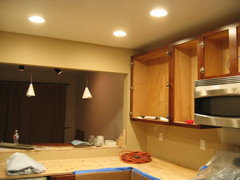
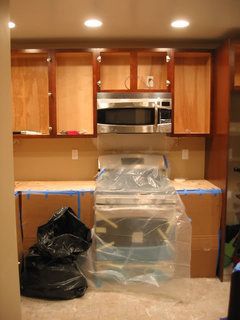

Below are pictures with lights dimmed to the max (25% I think) -

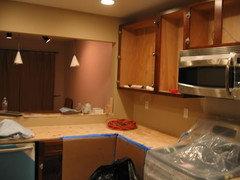


So you can see that the difference between dimmed and not dimmed is not very much.
We are also going to have undercabinet lighting for task lighting as well as pendant lights over the breakfast bar. So there will eventually be even more light! Perhaps then our kitchen will be visible from space :)
Hope this helps.
texasredhead
15 years agoI really have no experience with LED cans. I presume if you wanted a change you would need to replace the LED cans with IC cans. If the LED cans are new construction cans you would need to tear out the ceiling to replace them.
I do think many folks go over board on installing recessed can regardless of the type especially on low ceilings. IMO, the best use of recessed cans is for ambient lighting not to recreate daylight
I have read an interesting variety of posts on this board about cans and their placement. One individual didn't want her ceilings to look like pin cushions and was running into a GC and a lighting consultant both of whom were pressuring her to install cans all over the home. I remember installing eight 6" cans in a master bedroom because that is what the customer insisted on. The room was 14' X 16'.
Bottom line, as master electricians in Dallas, we spend a lot of our time installing recessed lights. It's all the fad.
sturdy
15 years agoAussies - When I saw your post, I got concerned because my husband declared we should use LED recessed lights. I googled "low voltage recessed lighting buzz" and came across a "Lamp Debuzzing Coil" at ylighting.com. I am not sure if this is solely for lamps on dimmers or if somehow it can be worked into your recessed lighting.
sturdy
15 years agoAussies - I also found that if you have an electronic transformer and have used an incadescent or magnetic low voltage dimmer you may get one or more of the following: dimmer buzz, fixture buzz, lamp flickering, interaction between circuits, radio frequency interference, and may damage the dimmer or transformer. So you may want to double check the compatibility of the dimmer with the LED units you purchased.
sturdy
15 years agoI just checked your dimmer switch. It looks like it is an incandescent dimmer switch. You need an electronic or magnetic low-voltage dimmer depending on which type of transformer you have. This would explain your issues (see my previous post above).
Lee
aussies
Original Author15 years agoActually, I'm ashamed to say that I've decided to just take them out and put in low-voltage halogen for now instead. I really wanted to be energy-efficient, but in my situation, these LEDs just didn't work out. I will have fluorescent undercabinet lighting, and FWIW I plan to switch out the recessed halogen bulbs for LEDs as soon as the technology is a little further along. I don't like my lights too bright, so I will probably have the halogens dimmed most of the time anyway.
The LEDs weren't low-voltage, so I don't think it was the dimmer. The dimmer I used was one that was recommended on the Cree website.
My advice to others would be to definitely try the recessed LEDs. In other applications, perhaps with higher ceilings, or with fewer lights, or for someone who likes a lot of light, these lights would probably be suitable. Maybe the strobe effect was something particular to my house ... I don't know. But I would recommend buying them from a place that will accept returns if they don't work out. I bought mine from a local Lamps Plus store and they have been great about being willing to accept returns and work with me on a different solution.
kaseki
15 years agoWow! I personally can't imaging having too much light, short of direct sunlight. This may be due to having older eyes, which generally require higher illumination levels for detail work.
With respect to the dimmer, I suspect the problem is the following, which I hadn't thought of until you wrote. Now I will have to think about (and maybe experiment about) how I might overcome the problem if I use the Cree lights and want to dim them.
Many modern low electrical interference dimmers reduce the number of cycles of current passed, rather than reducing the fraction of each cycle passed. For tungsten based lights, the light's thermal inertia (time constant) is long enough to average much of this modulation. At the 20% level, the LEDs will be energized at one-fifth of the 60-Hz line frequency. This is 12 Hz, and visually disruptive. Even if the dimmer controls positive and negative half cycles separately, there will still be a 12-Hz component in the modulation.
The reason 20% output still looks bright is that the eye has a logarithmic response. Each factor of 2 dimmer or brighter will look like a small change. That is why we can see in starlight and in sunlight, many orders of magnitude different in illumination level. With incandescent lights, the reduced power level from the dimmer reduces the filament temperature. This not only reduces the lamp's total output, but also shifts its spectral peak farther into the infrared, reducing visible output by two factors at the same time.
A better dimmer for the LEDs _might_ be a variable transformer, e.g., a Variac. The Variac could be modestly sized when only powering n x 12W of LED lights. The Variac type dimmer would have to be used in addition to a switch, rather than having a dimmer with a built-in switch. Such devices may require an odd sized electrical box, and would normally need to be UL or equivalent rated for power control purposes.
Thanks for the observational report, even if you have changed to another approach.
kas
snoonyb
15 years agoInteresting!
Ive experienced your symptoms with all kinds of lighting and my first response was not to question the product, but the supply.
1st change the dimmer.
2nd varify the ground is clean.
3rd run a dedicated circuit to that areas lighting ONLY.So I suspect that you have received bad advice and do not have knowledgeable people working with/for you.
Sorry to hear that you have elected halogen as the solution, however, on the brighter side, you can use your kitchen floor as a bakery.
izbit
15 years agoWe also have the CREE lights, and while I haven't heard any buzzing, we do have flickering when we dim them close to the maximum. And yes, they're brighter than I expected from the specs -- I'm very glad I didn't let our contractor convince us to add extra cams when we decided to go with the LEDs. (Instead we went with a pair of very pretty mini pendants that we rarely bother to turn on, but that look nice even off.)
suzy_zone6
15 years agoI also have several of the Cree LR6 6" Recessed downlights. We love them...although we don't have dimmers. I had a lot of questions about the lights before I ordered them (from Homeannex.com) so I went to the Cree website and found their telephone number. I called and spoke to a representative there and they were extremely helpful. Their support telephone number is: US Toll Free: 866-924-3645. Try giving them a call with your problems. I'm betting they can help you. Best of luck! :)
lucypwd
15 years agoWe plan to use cree 6" - I had the contractor add two additional cans over the sink as I didn't want it to be too dark - ha! We have several in place now as a trial, although the kitchen is not yet finished. I find the light very warm and nice. The dimming function is lame though - it doesn't really dim to the point where you feel it is subtle or dimmed light. Yes, it is dimmed but no, it doesn't seem very different than full on light. I don't notice a buzzing - that would drive me nuts. How much did you pay for the CREEs?
snoonyb
15 years ago"lucypwd"
Try a single dimed fixture over the sink and you may find that you can acheive the desired effect with just that fixture.kaseki
15 years agoUpdate on dimming the LR4.
I obtained an LR4 for testing with a Variac. (The Variac is an autotransformer that reduces ac voltage while keeping all the cycles intact.) The LR4 still shut down at 20%, indicating that its internal power supply drops out at that level. Flickering was seen just above the 20% point, suggesting that the flicker is not due to dimmer cycle stealing, as I incorrectly guessed above, but due to the power supply trying to decide whether it should be on or off.
20% dimming is inadequate, in my opinion, if one wants subdued lighting. My intention now is to use the LR4s where full power is desired, and incandescents where significant dimming is desired.
The other test I ran was to check that the spectrum of the simulated 2700K color temperature LR4 wouldn't make the colors of my particular soapstone inclusions, granite inclusions, or backspash tile different than with incandescent lights. The LR4 passed this test, so I consider it good for my kitchen counters, so long as significant dimming is not needed.
kas
bullheimer
13 years agobump. ps, those light fixtures they talk about in here are currently $200 clams a piece.
know if they got the lamps to dim past the 20% mark in the last two years?
David
13 years agoCR6 lights are supposed to dim to 5% and cost ~ $50 (49.97 @ Home Depot online).
I'm pretty happy with my LR6 lights (~$80).
cinnamonsworld
13 years agoThis is all pretty interesting. I'm gonna buy candles.
If you haven't ripped out the LEDs just yet, I wonder if you'd notice any difference in the strobe and buzz when no other power draws are on in your house (so A/C off, other lights, etc.) vs. turn everything on including the washer/dryer/dishwasher/A/C etc. If it disappears in the first case or really ramps up in the second, that tells you something about your house's wiring being part of the issue. What exactly it tells you though, I'm not 100% sure.
DavidR
13 years agoDisclaimer - I haven't worked with LEDs and dimmers yet, so I'm speaking theoretically here.
I can easily imagine the problems an LED would have even with an old fashioned thristor dimmer, which just reduces the portion of the AC sine wave passed. First is what it's likely to do to the electronics which power the LEDs, which are fundamentally low voltage devices. The gross distortion to the waveform can really make a power supply unhappy, especially an electronic "transformer."
Also, unlike an incandescent light which has lots of latency, or even a fluorescent which will have at least a little latency in its phosphor, an LED is theoretically going to be dead off the nanosecond the power is off.
No doubt the fixture's power supply electronics will have some effect on this, but of course it depends on whether those electronics are designed to deal with the gruesome waveforms that dimmers produce. I'd expect the effect to be unpredictable if you're not using dimmers that the manufacturer has confirmed as compatible.
Autotransfomer (Variac ® - yes, it's a trademark, in case anyone cares) dimmers as mentioned by Kaseki should minimize or eliminate this effect. He may know some I don't, but the autotransfomer dimmers I've been introduced to over the years have been mighty big and mighty expensive.
There's a relatively recent trend - maybe the last decade or less - in theatrical light dimming. "Sine wave" dimmers use IGBTs rather than thyristors. You could think of "sine wave" dimmers as variable output switching power supplies. I don't know whether any of these dimmers have yet been developed for home use. If not, I'd guess they're on the way.
Again, my yammer here is all theoretical, so listen more closely to the folks with real world experience on this.
Here is a link that might be useful: Sine Wave dimming
lee676
12 years agoI've bought LED Christmas indoor tree lights, from major brands like Philips, that flicker so badly, even when not dimmed, to be impossible to look at without bothering my eyes. The Xmas lights I eventiallly bought at HolidayLEDs dot com , while overpriced, at least stated "no flicker" in their specifications and explained why cheaper LED bulbs flicker on their website (and sure enough, the indoor lights I bought from them don't flicker at all).
I haven't tried dimming CR6s yet, but when full on they don't appear to my eyes to be flickery at all. That's more than I can say of a few cheaper LED retrofit bulbs I've tried, with the 40w equivalent 3000K Philips A19 shape (the clear/frosted bulb where you can see a yellow spot through it) being the worst offender (although not as bad as their Christmas LEDs.
Granite_Man
12 years agoI agree with you on the Philips A19 LED. I find them to be awful.
However, back on topic, I am happy with the CREE product and have experienced no issues with buzzing when the cans are dimmed.
lee676
12 years agoOT, but if that's an Advantium oven I see there, it's worth an upgrade to the 240v version. The 120v has so little power to work with that it's effectively just a microwave oven with a 500 watt halogen light to add a bit more crispness. The 240V over-the-cooktop Advantium has a much more robust 2400 watts of halogen light to work with, as well as a slightly more powerful microwave and a second ceramic heater that doubles their power from 500 to 1000 watts. Not only faster, but better cooking results (I've used both, the A240 is a substantial improvment, but even the A120 is much nicer to have and more versatile than a plain microwave oven or even a microwave/convection oven.) Settle for the A120 only if you don't plan on using the speed-cooking features often.
The Cree CR6 is the best-looking reasonably-priced LED recessed light I've seen (most others are lower CRI around 80 rather than the Cree's 90+, and inflate brightness/lumens by resorting to cooler 3000K or higher color temperatures rather than the Cree's warm, incandescent-like 2700K. Many aren't dimmable down to 5%. And the Cree just looks and feels like a quality piece. Experiment with dimmers and if necessary, wiring until they don't buzz; clearly it's possible since others have done it.
footwedge
12 years agoI also purchased the Cree CR6 bulbs and the Cree can but they are not installed. I called Lutron a month ago and the dimmer they recommended is the DVSCCL-153P which is not on the list.
I hope I like them and they dim more than 20%.
triphase
12 years agoI wish I had seen this sooner. The answer to your dimming issues will be solved with an electric low voltage dimmer from lutron. Lutron LN-DVELV-303P.
This will take care of all the LED's out there that have any and all noise and stobe light effect (flashing) The dimmer is a bit pricy but it WILL fix your problem. Even the new Diva's from Home Depot that are LED specific won't stop all the noise and possible flashing issues. We use this dimmer here at tri-phase electric since we install a ton of LED recessed lights. It took a while to figure this all out, but once we did, all the customers were shocked at how good these lights and dimmers are.Mike
chaparral
12 years agoWe are about to put recessed LED lights and just had a demo. The units are produced here in SoCal by Nora Lighting. We checked out a 6", and it definitely puts out a lot of light; supposedly similar to a 75W incandescent. Our electrician brought a low-end dimmer with him and we were impressed at how well the unit dimmed and the lack of flicker. Maybe the technology has simply improved a lot in the last 3 years since the original post?
footwedge
12 years agoAlso posted this in another thread. I just finished installing 6 Cree CR6s using the cree can and lutron dimmer DVSCCL-153P. I must say we are very pleased. Yes the light output is bright but they also dim very low with no flickering or noise.
For those having issues with the CR6, I highly recommend this dimmer.
toddimt
12 years agoI had done some preliminary prewire and setting of Halo H7ICAT cans so I can see how well the CR6 cans light up the room with what I was thinking. I hooked 5 cans up to an existing Lutron Dimmer I had. Seems like nice light and they dim nice and low. Now I did notice something with the dimmer that could be the cause of the original posters issue.
When you turn the lights on but not all the way so they are dimmed, maybe 50% or less, I did notice flicker. Although did not appear to be all the bulbs.
However, If you turn the dimmer up all the way or most of the way up first and then back down its fine dimmed with no flicker at all. Again, not using one of the newer dimmers, with the adjustable wheel and not sure if this is even an approved dimmer period. I think its a Lutron Skylark but is probably at least 20 years old. Not sure if the bulbs behave the same way on other dimmers. I don't see it being as bid a deal if this is the case, since usually I would have the lights on and then back them down when eating, etc.
brickeyee
12 years agoI do not get the draw of can lights for general illumination anywhere or task lighting in kitchens.
They are not very good at either.
For general illumination the almost entirely down pattern (even with a flood bulb) is inadequate unless the bulb protrudes below the bottom of the can.
For task illumination they need to be in front of the person, and even them tend to show strong shadows that are distracting unless you put them close enough to each other to ensued �double coverage� of the work area.
If they are behind the head of a person standing at the counter to work they block the light.
Under cabinets work well for task lighting; especially when supplemented by adequate overall lighting.
The under cabinets are often installed farther apart than desirable though.
You still need �double coverage� to have good task lighting.
If the cabinet bottom is around 18 inches from the counter, puck type light need about a 12 to16 inch spacing.
If you want to crate visual affects of greater separation, put them on separate supplies and leave half off and dim the other half.
I just turn mine off or dim them all when prep is completed and they are no longer needed.
The overall lighting is a 4-tube T8 48 inch fluorescent that is nice and uniform over the galley type kitchen (48 inch light in 12 foot long kitchen).What you see on TV and in decorating magazines is often not all that useful for actual cooking, most of which is prep.
Even notice the very brief prep periods (if any) on cooking shows?
No on want to watch 10 minutes of chopping and cutting.Sometimes it is as bad as folks with 15-speed bicycles that have not figured out when to change the gears.
greatcakes
12 years agoI am disappointed with my lights too, but for a different reason. when they are off, and you look up, you can see some of the electrical casing behind the bulb. the bulb doesnt' fill the whole space, so you can see the model # of the can..does anyone else have this issue and what did you do?
thanks!pbinCA
10 years agoMy suggestion to anyone installing LED cans and dimmer controls is to prototype the installation on the floor before committing to installing the parts. This is because there are not standards yet with which to back up a claim of compatibility. If the installer has experience with the specific parts already, that would qualify as having prototyped.
I would back up and prototype the dimmer and 1 LED light on the floor. See if the humming effect repeats with just one LED.
If so, I would try a different dimmer control.
If the sound is gone with just a 1 LED load, you might be overloading the dimmer. What is the wattage rating?
Are your 2 pendant lights on the same circuit? Are they LEDs? Don't try to mix ICs and LEDs on the same circuit.pbinCA
10 years ago60W and 40W vacuum incandescent bulbs are being phased out in the U.S. at the end of 2013. It would be foolish at this point to be designing in fixtures assuming these bulbs. The US law passed in 2007 is agnostic about bulb technology, but just regulates efficiency (lumens / watt). Obviously, CFLs and LEDs are a pass.
Halogen incandescents might survive this regulation. However, they do generate a great deal of heat, so much so that they will discolor wallpaper, and burn flesh nasty.
Designsmith1234
10 years agoIs there any type of film that can be put over the LED lights that can help filter out the light? I have appropriate dimmers, but there is still too much light coming from the recessed lights. If I had known about this brightness issue, I would have installed fewer recessed lights. It's done now. I don't mind the brightness in the kitchen, but I cannot watch television in the living room. I find I just don't turn them on, and use lamps instead.
attofarad
10 years agoDesignsmith1234, what type of LEDs do you have,
and what dimmers? Some LEDs dim better than others.
Also, some dimmers have an adjustment on the
low end -- maybe yours do and it needs to be turned down.jackfre
10 years agoGood post! Sure is a long one! I have used LED cans through-out our new re-model of two baths, laundry and Kitchen. I like them a lot. I have a stroboscopic effect in the two 4" cans over the bathtub periodically and intend to speak with the electrician about that, but otherwise I like the kitchen cans a lot. My kitchen is 16x20 and I have the cans switched it 4 banks. As well I have 2, 3 & 4' florescent under counter lights, again switched separately from the cans. I also have 3 pendants (yet to pick them out). I think you should talk to your electrician about breaking the lights up into two or three switched banks that you can bring on as you need them. Another thing. I found that it looked like a sports stadium when the lights were first tuned on and there was nothing in there. Once we moved in an placed furniture, area rugs on the new hardwood and kitchen goods on the countertops, it toned things down. Something else that helped us is that I have soapstone countertops and they are non-reflective. We like them a lot.
kaseki
9 years agoSomeone "liked" some comment I made on this topic so I thought I should provide an update.
My reno was mostly completed by 2011. The final kitchen lighting configuration was 12 Cree LR4s (I think, its been a while) in three banks of four. Cans are variously at 8 or 9.5 ft high. No dimmer is used. A 50W halogen flood over the main sink with conventional dimmer provides reduced lighting when a truly dim room light level is desired.
There is useful dimmer information above that was provided after I was finished with lighting design. I could retroactively experiment with dimming, but I don't feel a need to dim the Cree lights in my configuration.
kasSKP Design
9 years agoI will mention that in a commercial setting, I have seen recessed fluorescent lights (2' x 4' fixtures) replaced one for one with LED 2' x 4' fixtures, and the result with the LED's are that they are MUCH brighter. Almost too bright. I think it is possible to use or need less light fixtures with LED's.
Electric Matter Corp.
9 years agoYou are damaging the drivers if you hear a humming. Not all dimmer (even if its manufactured for LED) are the same, you have to get the dimer that Cree recommends. Its most likely a Lutron CL dimmer, my suggestion is the slider with the switch on the bottom.
Hope this helps.
wenjiang0530
8 years agoLong life capacitors in LED LIGHTING APPLICATIONS
Shanghai Yongming Electronic Co., Ltd., which is a China-based manufacturer focused on designing
&producing Aluminum Electrolytic Capacitors. Qualities has approved by current customers PHILIPS GE
OSRAM TOSHIBA.
Radial Leading capacitors in LED DRIVER, POWER SUPPLY:1. Super long load life LLK series 20000hrs, LKZ series 15000hrs, LKG series 12000hrs at +105C
2. Super high temperature LKL series 5000hrs at +130C
3. More smaller size LK7 series size 5*7mm, LKM series size 5*9mm
For datasheet and free samples if need, pls TEXT me at +1-2018985566 or whatapp+8615653007886or email to cwj(at)sh-ymin(dot)com/////
////www(dot)facebook(dot)com/shanghaiyongming////
///////www(dot)sh-ymin(dot)com///////
Kind RegardsJohnson
Shanghai Yongming Electronic Co., Ltd.
Fengxian District,Shanghai 201406, China
Office:+86-21-33617848
China +8615653007886
US +12018985566
robilory
7 years agoIf you want to know who many recessed lights you may need, i found a great calculator that could help you out : http://en.lumenco.ca/actualites/recessed-lighting-calculator/
Courtney
6 years agoI just had LED lights installed for the kitchen ceiling. I hate the sterile very-white white cold light. You mention you have a "warm" color. What is that? I hate this and my electrician doesn't seem to think there is a softer more-halogen like option. Can someone tell me any suggestions? Help
attofarad
6 years agoCourtney, the LEDs should show a "color temperature" on the box they came in. "Warm" is in the range of 2700 degrees, and is yellowish, like a standard incandescent bulb. 3000 degrees is noticeably whiter, at least when viewed in close proximity to the 2700, and is close to a halogen bulb in color. "Daylight" is more like 5000 degrees ("colder" looking, even though the colder temperature is higher), and is much much whiter.
Courtney
6 years agoThese are 3000K and called "bright white" and i'm praying they come in a version of 2700 "warm white" but electrician doesn't think so. These are called "ultra-thin wafer downlight" recessed LEDs by Lithonia Lighting, and are round, 4 inches.
Thank you for the reply!kaseki
6 years agoLight sources have a spectrum. In some cases it is narrow, and in others wider. The sun, for example, emits through the entire visual spectral band, as well as UV and IR. tungsten and tungsten halogen are hot emitters with various spectral bands generally characterized by their apparent color temperature. The sun's spectrum is close to that of a 6000K (degrees kelvin) black body, whereas tungsten lights may be 2700K and tungsten halogens up to 3300K. The latter color temperatures are considered lower than the sun color temperatures, but are called warmer. Arc lamps that are spectrally broad may fall into the same color temperature range as the sun, but depending on line structure from the gasses used and the pressure that they are running at, may appear redder or bluer than the sun.
Note that as these thermal sources are turned down with a dimmer, they become redder (warmer color) even though they are getting colder, physically.
Now, getting to light emitting diodes, there are two types that I'm aware of being used for illumination (excluding variants). One type emits mainly at a single color, but because they are not true laser sources, this color band may be somewhat wide. Combinations of these sources may be used to try to match the tristimulus diagram of human eye response and look like a black body emitter at some color temperature. High color temperatures are considered colder because they have more blue; lower temperatures are considered warmer because they have more red. Note that this is referring to color temperature, and not LED physical temperature.
The Cree LR4s had a scheme for re-balancing the color temperature as the LEDs aged. As I recall they were available in two different color temperatures for different applications. A clothing store, for example, might want a higher (colder) color temperature for interior illumination, whereas a kitchen might prefer something warmer (lower color temperature). (No one should be embarrassed if confused by this contradictory nomenclature.) Cree provided me a (proprietary) spectral chart that showed that their color spectrum was broad, but not particularly close to matching a black body spectral diagram. To avoid any post construction complaints I bought a single lamp and tested it against my soapstone and granite to ensure that the green highlights in each were being properly illuminated to provide a pleasing color balance when illuminated with the warmer LR4 option.
The second type of LED source uses a deep blue or UV LED (or array of LEDs) to illuminate a phosphor or a combination of phosphors intended to emit a particular "whitish" color temperature. These phosphors tend to look yellow when viewed with the lamp off. By choosing the phosphor chemistry, and possibly over coating with filters, different color temperature sources are created. The goal is to know what color temperature one wants before specifying the particular lights to be used. If you want a tungsten halogen color temperature, specify 3200K - 3300K. For regular tungsten, 2700K - 2800K is good. Higher values toward 4000K will be bluer and more blue sky matching.
As an aside, LG was able to cut the cost of organic LED (OLED) TVs by using all white (phosphor) blue-emitting OLEDs with red/green*/blue filters rather than the more difficult to manufacture sets of red/green/blue single color LEDs.
kas
*maybe yellow, I'm to lazy to go look


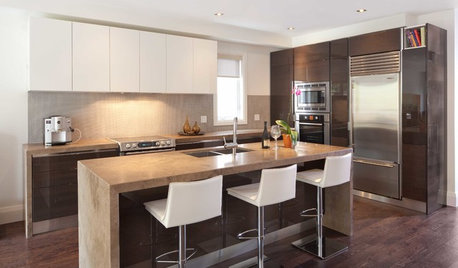
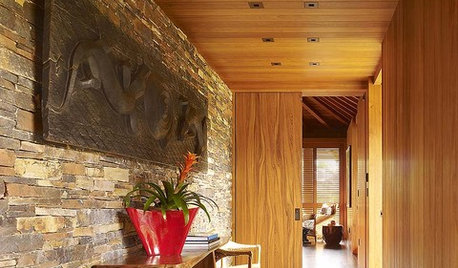
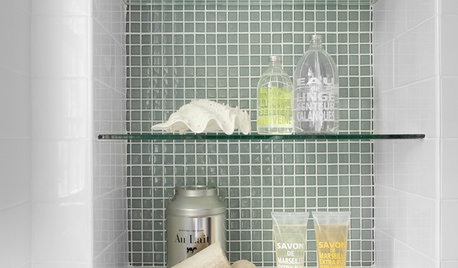


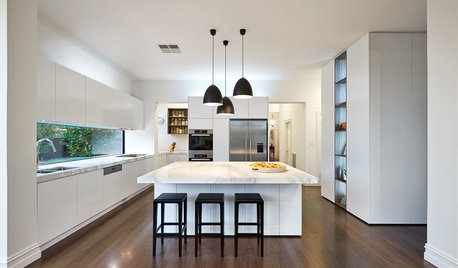

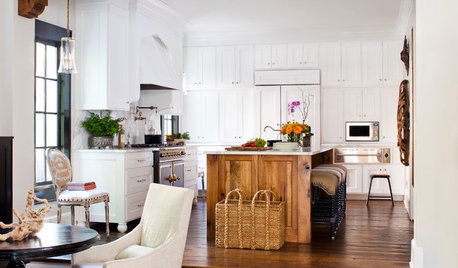






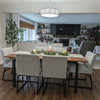
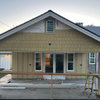
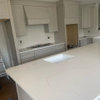
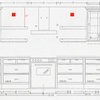
texasredhead